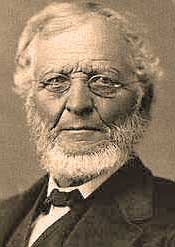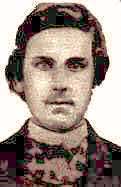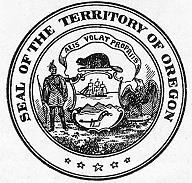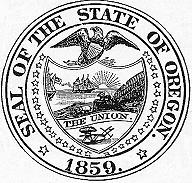 Churches of Christ & Christian Churches in the Pacific Northwest - WILD GROWTH - Interactive Crossword Puzzle |
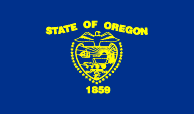 February 4, 2006 by Charles Dailey |
Church on Wheels | News from Oregon | Taking the ValleyGiants | Gospel Meetings | Social Life | The Convention
The Missionary Society | The Music | Among the Indians
Next Chapter . . . Pioneer Menu . . . Search
"The First Church on Wheels"
Martin Peterson (1820-1889) came to Oregon in 1864, crossing the plains in an emigrant train. He found 30 disciples among the travelers and held services each Lord's Day. He called it "The First Church on Wheels." Peterson was responsible for establishing the church in Medford, Ashland, Central Point and Grants Pass.
The stories of these communities are listed: Medford, Ashland, Central Point and Grants Pass.
News from Oregon

|
Publication Office |
In this letter, the reader can see the heart of this great man and some of the reasons his work for the Lord was so successful.
Bro. Glenn O. Burnett and myself commenced operations in the spring of 1847 and the good results far exceeded our most sanguine anticipations. The incentive was sufficient to induce us to spend all the time which our domestic avocations would allow, in the proclamation of the glad tidings among our new neighbors. Many turned to the Lord, and became obedient to the faith once delivered to the nations. Some of the richest and most refreshing seasons from the presence of the Lord, ever witnessed by me, have been in the wilds of Oregon. It possessed a charm which, under the circumstances, no pen can describe.
At our public meetings, perhaps a dozen familiar faces would be added to the number of the congregation while preaching, who had not seen us, nor we them, for years before; but who having heard of us and the appointment, came a distance, not to see one who had risen from the dead, but an old friend and brother, who, like themselves, had come to the distant shores of the Pacific. When the sermon and exhortations were over, and, as usual, the songs of praise would commence, then, with eyes sparkling for heaven, through tears of joy, we would greet each other in the transport of Christian love; and to witness brothers and sisters, and not unfrequently parents and children, embracing each other in tears of love and joy, while singing, gave to the scene a zest, a richness and a charm, which no tongue can tell, nor heart conceive, who has not been one of the number.
We have now six respectable churches in Oregon: some are small, as a matter of course, while others are large and flourishing; and though we are doing as well as our neighbors, yet I must confess, that the gold of California has, to some extent, shaded our prospects. We have seven or eight preachers, yet three or four do all the labor, without pecuniary assistance. We have talented and influential opponents, who enjoy "sanctuary" ease and opportunities, while we are poor, (and wealth, you know, has its charms,) and are, therefore, deprived of doing what otherwise would be easy to accomplish.
Our opponents have earthy advantages on their side; but we have God our Father, the Lord Jesus Christ and the Bible on our side - hence, we thank God and take courage. Our numbers, at present, are greater than any other denomination. May God smile upon us, and save us in heaven at last! Write me soon. Affectionately your brother,
"LAFAYETTE, Oregon Territory, March 24, 1850.
When I landed in this Territory, in September, 1846, I had the pleasure of meeting many old friends and brethren, whom I had known, in former days, in the States, and who had preceded me to this country. The greeting was cordial. Our brethren had organized two respectable congregations, but they had only one preacher - Bro. Foster. Bro. Harney some times gave excellent exhortations, and is worthy of the highest commendation for his good sense and Christian zeal in fire-side conversation.
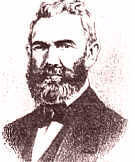
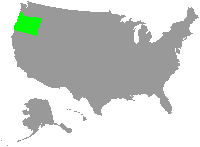
JAMES M'BRIDE."
Millennial Harbinger, 1850, page 592.
The spelling and punctuation of the orginal have been maintained. There is a profile of Dr. McBride.
Ernie Chamberlain observes "that the disciples who came to Oregon were not the unemotional and legalistic body some would have us believe." Indeed, feel the emotion is McBride's letter.
Taking the Valley

|
In 1851 came three brothers, John, Alfred and Noah Powell, all preachers. They settled in Linn County. John is noteworthy since in 1852 he was the church planter of the Restoration churches in Oregon. He traveled horseback the length of the state establishing churches.
There are profiles of the Powell brothers. The Linn County location is shown on this map.A church was organized at Pleasant Hill (in Lane County, near Eugene) in 1850 by Elijah Bristow. It met in a log building from 1858 until 1872. The church continues to this day. Other early churches were at Carver in Clackamas County and Blackhawk, near the present McMinnville.
These links are to the sites: Pleasant Hill, Carver, Blackhawk.The "Annual Meetings"
In the summer of 1852, Glen O. Burnett called the disciples of the Willamette Valley to assemble for fellowship and worship. Until 1996, the view has been that this first annual meeting of the disciples was in an oak grove near McCoy and a half mile or more west of Bethel. (Swander, Smith) Research by Dr. Jerry Rushford shows the meeting was in September of 1852 at Central, east of Albany. While the meeting was mainly for preaching with three sermons a day, reports from various churches were given, a little business transacted, and John Powell was selected as evangelist to plant churches. C. F Swander says, "A convention would doubtless have been unorthodox at that time."
Glen Owen Burnett
There is a profile of Glen Burnett. Bethel is described in detail. Central is also fully described. There is a profile of John Powell.At the 1852 meeting 300 people attended from 10 congregations. During the meeting, Glen Burnett reported, "We have in Oregon about 1,200 disciples, but in a most disorganized condition." Certainly a growth from 13 disciples in 1846 to 1,200 in 1852 shows a dynamic and evangelizing church even if it was disorganized!
E.B. Ware was writing about California, but it applied equally well to Oregon when he wrote:
Within a decade there were annual meetings of the churches, actually encampments, primarily for evangelistic purposes. These meetings, developed between 1860 and 1870, were of a special character. Entire families would gather. Tents were erected in fields at the edge of a town where there was a Christian Church and an adequate supply of potable water. Food would be available for cooking (frequently a gift of farmers nearby). Preachers, especially, looked forward with keen anticipation to these gatherings for fellowship and the opportunity to exchange views, opinions and church news with fellow preachers.Giants in the Land
The preachers that led in this growth were hard working men. Most farmed six days a week. They studied for sermons by candlelight.
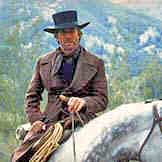
On Sunday mornings, they mounted their horse and headed for their preaching point. If they didn't have their sermon finished, they rode slowly and worked on it.
If they didn't have a horse, they walked, in some cases nine or ten miles. The weather did not stop them. They held church at 11 A.M. and 3 p.m. (The time of the services were controlled by the need to do chores and milking.) The tradition of meeting at 11 A.M. remains to this day.
Many times the preaching was out under the trees rather than in church buildings. Revivals were popular. They were usually held after harvest and lasted for days, sometimes for several weeks. We do not have numbers for the Christian Churches and the Churches of Christ, but at one point there were 57 circuit-riding Methodist preachers and just 38 with fixed churches.
C. F. Swander says of the Restoration preachers,
But there were giants in those days - giants in hardened muscles, giants in faith and giants in preaching the Word. They were unhampered with classical learning, yet some of them could read the Greek New Testament more readily than most of the moderns. Their libraries consisted of a few, but well chosen, books. Above all else, they knew the Word and preached it.
Describing the fervor of the times, Swander writes,
The spirit of evangelism moved those early pioneers. There were no secular attractions, or amusements, to distract the minds of people. Movies had not yet been invented. Dancing may have been indulged in, but it was not a mania. . . . . Nor were the people of that day content with sermonettes - they demanded full grown sermons. Those were giant preachers and they must deliver giant sermons - two and three hours in length sometimes.
At the 1853 meeting John Rigdon (cousin of Sidney Rigdon of LDS fame) was appointed evangelist and "preached from Jacksonville, in the extreme south part of the state, to Steilacoom, in Washington Territory, on the north." One observer had said of Rigdon while he still lived in Iowa:
John Rigdon
Among the prominent preachers of that period, was John Rigdon, who moved into Louisa County at an early day, and travelled and preached from Lee County on the south, to Jones County on the north, and as far west as Keokuk County, in a kind of irregular evangelizing. He is described by Bro. F. B. Lowery as a strong preacher, reasoning with great force and clearness.
This quotation is by historian J. B. Vawter. After arriving at the location, search for "Rigdon." There is also a profile of John Rigdon.These gatherings under the name of "annual meetings" continued until 1860, meeting near Rickreal and in Dallas in Polk County. (Rickreal was also known then as La Creole and Dixie.) Other sites were Luckimute, Aumsville, Monmouth and Eola in 1860.
Map showing location of Polk County.Gospel MeetingsThe real outreach power of the pioneer churches was in the night-to-night preaching meetings. They lasted two, three or even four weeks. They were advertised so that everyone knew what was happening down at the church. In today's multifocused society, it is difficult to find one form of advertising that reaches everyone.
Members came and brought their friends and neighbors. Now, members have lives so scheduled with activities, they are not available to come in the evenings.
Sometimes the gospel meetings were conducted by one man, but often a song leader or singing evangelist would accompany the visiting preacher.
Sometimes a protracted meeting was started by one preacher and another would come to finish the meeting. At other times, several men skilled in getting decisions were on the target field at the same time.
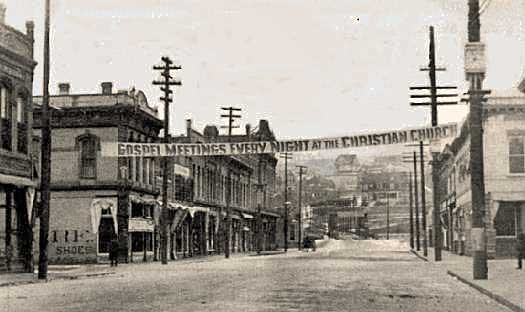
Looking north on S. Main in Pendleton, Oregon The photo was probably taken around 1905 in Pendleton. No autos are in sight, but the town had electricity. The Pendleton Christian Church had a series of Gospel Meetings in their first few years. The scene is typical of the era of gospel meetings.
Social Life Among the Churches
One glance at the pioneer church buildings reveals that they were not the center of the believer's social life. They would seat 50 to 150 people on benches and there was a place for the speaker at the front. When we build now, we build the "fellowship hall" first and use it until we can afford a "sanctuary."
Some State Seals
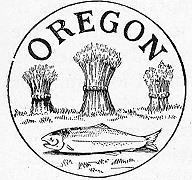
Used by the provisional
government in 1846Seal used in 1846 by the
Territorial government.
The Latin is
"I fly with my own wings."The first seal
of the new State.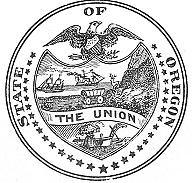
Seal in use in 1899. The family itself was the center of social life for women and children. Of course, there was "dinner on the grounds" at church when the weather permitted. And there were camp meetings at least yearly, if not more often. The entire family camped for a week and there was preaching every morning and evening. Ladies visited, young people were quietly selecting life partners. The men visited and played horseshoes.
Aside from church life, the fraternal groups played an important part for men. Prominent among these groups were the Masons and the Odd Fellows. With the rise of the vocational preachers, there was someone to be the emotional hub of the church. A social life centered in the church came to replace a social life centered in the fraternal groups.
The changing design of the church buildings documents the transition to a church-centered social life. Some buildings were raised a foot or two and a basement was added. With others, classroom wings were added that could inconspicuously double as social areas.
The Missionary Society
The 1860 "annual meeting" was pivotal. The Christian Missionary Society of Oregon was formed and James R. Fisher was elected president. Those in attendance from the congregations were considered messengers.
By 1870, one observer estimated the number of disciples at the "Annual Meeting" to number between 5,000 and 6,000 souls. He believed it was the largest meeting of any kind in Oregon.
The Missionary Society lasted until 1877 when it was replaced by the Annual Christian Cooperation, a delegate convention. The Missionary Society conventions and gatherings met at Bethany, Central, McMinnville, Bethel, Monmouth, Rickreal and at Dallas in 1877.
Another transition came as the Annual Christian Cooperation was formed at the Dallas meeting. That year, 30 churches contributed $449.25 to evangelistic work. With the forming of a combined treasury, a new era had been entered. With offerings flagging in 1878, two men were assigned to canvass the churches and about $2,400 was collected for outreach. Churches hosting the yearly ACC meetings were Monmouth, Amity, Eugene, Salem and in 1885, Turner.
The Convention
The ACC became the Christian Missionary Convention of Oregon in 1888. Because of legal technicalities, the name was adjusted to The Oregon Christian Missionary Convention. The Turner Convention has met each year since except 1911 when it was held in Portland to coincide with the National Convention of Christian Churches.
In his book, Making Disciples in Oregon, C. F. Swander includes the following resolution made by the OCMC in 1919:
That we look with favor upon any movement for the union of God's people and the answer of our Saviour's prayer that is consistent with the divine authority as revealed in the Gospel of His grace, and that we pledge ourselves anew to the great plea for the restoration of the church of the New Testament; and that in these days of unrest we plead more earnestly for the basic condition of membership in His church as faith in the Lord Jesus Christ, confession of that worthy name before men, repentance from the heart of all sin, and baptism into the name of the Father, Son and Holy Spirit, followed by a holy life; and that we reassert our blood bought liberty in Christ to go anywhere and everywhere without hindrance to proclaim the gospel of His love.As the ACC concerned only a few - the delegates, the state camp meetings were discontinued in favor of county camp meetings. These meetings were wildly popular and were finally combined at Turner in 1885 and called the "Turner Meetings."
The Music
While the singing in many pioneer church services was without instruments, that was not always the case. This circuit-riding organ is located in the Cottage Grove Historical Museum. The lower portion of the pump organ folds into the case so the instrument can ride horseback behind the circuit-riding preacher. It was manufactured in 1871 by the historic Estey Organ Company in Brattleboro, Vermont.

More can be learned about the Estey Organ Company at their museum site.Historian James DeForest Murch addresses the singing of the churches:
"Like a mighty army" the Disciples sang. They not only sang the great traditional hymns of the church with zest, but they loved their own "Bringing in the Sheaves," "There Is a Habitation," "The Beautiful Garden of Prayer," "The Way of the Cross Leads Home," "Tell Mother I'll Be There," and "His Eye Is on the Sparrow." . . . . The state and national conventions were veritable song fests symbolic of happy throngs on the victory road.
The music that accompanied the Restoration (Stone-Campbell) Movement is a study in itself. The work of Enos Dowling is on display at the Lincoln Christian College site and even provides a timeline of the writing and publishing of the music of the Restoration.
Among the Indians
As emigrants of the Stone/Campbell persuasion filtered into Oregon, the relations with the roaming Indian tribes was on a high level, although there may have been exceptions. Jerry Rushford details how pioneer William Lysander Adams taught Scripture to the Klikitats who wintered near his new home. They were frequent guests in the home and at church.

Christians on the Oregon Trail, 1997 editon, College Press, page 117.In the mid-1850s, Kurt and Jane Huntington came overland to Washington Territory to work among the Indians. Jane was killed in an accident and the project was halted. Preaching among the Makah Indians at Neah Bay was Charles Hubbel Hodges from the summer of 1873 to the late spring of 1874.
The Makah Indian Nation has their own web site.While no permanent work was established, the local Indians were not ignored in the spread of the gospel.
Next Chapter: Oregon Colleges or back to Pioneer Menu

